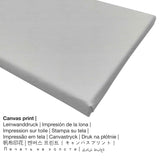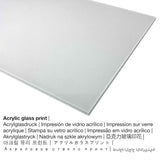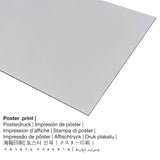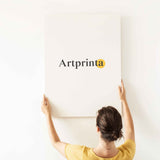Winslow Homer, 1906 - Moonlight on the Water - fine art print
Tax included. Shipping calculated at checkout.
What you should know the artpiece painted by the American painter Winslow Homer
The modern art masterpiece Moonlight on the Water was created by Winslow Homer. The 110 years old artwork measures the exact dimensions: 15 11/16 x 31 7/16 in (39,85 x 79,8 cm). Oil on canvas was applied by the American artist as the medium of the work of art. Besides, the artwork can be viewed in in the Los Angeles County Museum of Art's collection. This modern art artwork, which belongs to the public domain is being provided with courtesy of Los Angeles County Museum of Art (www.lacma.org).: . Further, the alignment is in landscape format and has a ratio of 2 : 1, which means that the length is two times longer than the width. Winslow Homer was a painter from United States, whose style can be attributed primarily to Realism. The Realist painter lived for a total of 74 years, born in the year 1836 in Boston, Suffolk county, Massachusetts, United States and passed away in the year 1910.
What kind of product materials can I order?
In the dropdown menu next to the article you can select your favorite material and size. The following sizes and materials are the options we offer you for individualization:
- Aluminium dibond print: These are metal prints on aluminium dibond material with an outstanding depth effect - for a modern impression and a non-reflective surface structure. A direct Aluminium Dibond Print is the ideal introduction to art replicas on aluminum. The bright components of the artwork shine with a silk gloss but without the glow. The colors are luminous, the details of the print appear clear and crisp. The direct print on aluminium is one of the most demanded entry-level products and is a modern way to display art reproductions, because it draws focus on the replica of the artwork.
- Canvas print: The printed canvas material mounted on a wooden stretcher frame. Also, a printed canvas makes a attractive and enjoyable feeling. Hanging your canvas print: Canvas prints are relatively low in weight, meaning that it is easy to hang up your Canvas print without the help of additional wall-mounts. Hence, canvas prints are suited for all kinds of walls.
- Print on acrylic glass (with real glass coating): A glossy print on acrylic glass, often denoted as a plexiglass print, will change the original artwork into beautiful home décor and makes a distinct alternative option to canvas or aluminium dibond art prints. Your artwork is being custom-made with the help of modern UV direct printing technology. This has the image effect of rich and impressive colors. The great benefit of an acrylic glass art print is that contrasts and granular artwork details will be more recognizeable due to the very fine tonal gradation of the print.
- Poster print (canvas material): Our poster is a printed flat canvas with a slightly roughened surface structure. Please bear in mind, that depending on the size of the canvas poster print we add a white margin between 2-6cm round about the print motif, which facilitates the framing with your custom frame.
Important information: We try all that we can in order to depict our products as closely as we can and to exhibit them visually in our shop. However, the colors of the print materials and the print result may vary slightly from the representation on the screen. Depending on your screen settings and the condition of the surface, color pigments can unfortunately not be printed as exactly as the digital version shown here. Because all the fine art prints are printed and processed by hand, there may also be slight variations in the motif's exact position and the size.
Article information
| Product categorization: | art copy |
| Method of reproduction: | digital reproduction |
| Production technique: | UV print / digital printing |
| Production: | German-made |
| Type of stock: | on demand production |
| Intended usage: | wall décor, home décor |
| Orientation of the image: | landscape alignment |
| Image ratio: | 2 : 1 |
| Interpretation of image ratio: | the length is two times longer than the width |
| Available variants: | metal print (aluminium dibond), poster print (canvas paper), canvas print, acrylic glass print (with real glass coating) |
| Canvas on stretcher frame (canvas print) options: | 40x20cm - 16x8", 60x30cm - 24x12", 80x40cm - 31x16", 100x50cm - 39x20", 120x60cm - 47x24", 160x80cm - 63x31", 180x90cm - 71x35" |
| Acrylic glass print (with real glass coating) size options: | 40x20cm - 16x8", 60x30cm - 24x12", 80x40cm - 31x16", 100x50cm - 39x20", 120x60cm - 47x24", 160x80cm - 63x31", 180x90cm - 71x35" |
| Poster print (canvas paper) size options: | 60x30cm - 24x12", 80x40cm - 31x16", 100x50cm - 39x20", 120x60cm - 47x24" |
| Aluminium print: | 40x20cm - 16x8", 60x30cm - 24x12", 80x40cm - 31x16", 100x50cm - 39x20", 120x60cm - 47x24" |
| Art print framing: | without frame |
Artwork information
| Name of the work of art: | "Moonlight on the Water" |
| Classification: | painting |
| Art categorization: | modern art |
| Period: | 20th century |
| Artwork year: | 1906 |
| Age of artwork: | more than 110 years |
| Painted on: | oil on canvas |
| Dimensions of the original work of art: | 15 11/16 x 31 7/16 in (39,85 x 79,8 cm) |
| Museum / collection: | Los Angeles County Museum of Art |
| Museum location: | Los Angeles, California, United States of America |
| Website: | www.lacma.org |
| License of artwork: | public domain |
| Courtesy of: | Los Angeles County Museum of Art (www.lacma.org) |
About the painter
| Artist: | Winslow Homer |
| Other names: | w. homer, Homer Winslow, Homer, homer w., הומר וינסלאו, Winslow Homer |
| Gender: | male |
| Nationality of artist: | American |
| Professions: | painter |
| Country of the artist: | United States |
| Classification: | modern artist |
| Art styles: | Realism |
| Lifetime: | 74 years |
| Born: | 1836 |
| Birthplace: | Boston, Suffolk county, Massachusetts, United States |
| Year died: | 1910 |
| Town of death: | Prouts Neck, Cumberland county, Maine, United States |
© Copyright protected | Artprinta.com
Original information about the artwork by Los Angeles County Museum of Art (© Copyright - Los Angeles County Museum of Art - Los Angeles County Museum of Art)
While living in Cullercoats in 1881-82, Homer reinterpreted the popular image of women anxiously searching the stormy North Sea for their loved ones. Quite unlike those heroic figures are the diminutive silhouettes in the museum’s painting, who very well may represent the summer visitors from the nearby hotels whom Homer and his family are known to have joined on at least one occasion as they watched the moonlit sea on the rocks near Homer’s home and studio at Prout’s Neck, Maine. On that occasion, the artist left the group, completing on the porch of his studio the charcoal drawing that formed the basis of his painting A Summer Night, 1890 (Musée d'Orsay, Paris), in which the figure at left in the museum’s painting seems to appear. Like the watercolor A Moonlit Sea, 1890 (Wadsworth Atheneum, Hartford), the museum’s painting may be a study for A Summer Night; or it may be an independent work of years earlier, related to the watercolor, Northeaster, dated 1883 (Brooklyn Museum), a daylight scene in which two women in tam-o’-shanter and round bonnet watch the sea from the rocks (although their positions are reversed). It can also be related to the painting Moonlight, Wood Island Light, 1894 (Metropolitan Museum of Art, New York), because of the exceptionally bold technique of both paintings. According to the art historian William Downes, that picture was painted in 1894 during an impulsive four or five hours’ work one night, entirely by moonlight, a seemingly impossible illumination for judging colors. Because of its exceptionally free technique, the museum’s painting is difficult to date on the basis of style. The connection with the works of 1890 seems most persuasive. For Homer, the moonlit sea was a recurring romantic theme in which the otherwise threatening sea seems tamed and charmed. The violence of the sea in Moonlight on the Water is somewhat unusual within this group. On the back of the painting the artist’s brother Charles, his executor, indicated the date 1906, a period when Homer was known to have begun no new pictures, only repainting old ones. While there is no evidence of repainting on the picture’s present surface, it may have been at this time that Homer restretched the painting, greatly changing its proportions by folding portions of the painting back around the stretcher at the top and sides to give it its present, unusually elongated shape. In adopting this format, Homer may have meant to accentuate the characteristics of the painting that relate to the Japanese prints he admired -- the theme of the great wave, diagonal compositional elements, silhouetted figures, and strong surface design.














